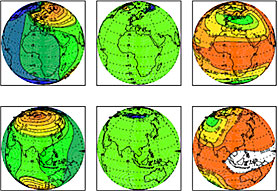GEMSIS-Ionosphere
Deductive Model of Global Electric Potential
We have developed a deductive scheme for the purpose of reconstructing the storm-time electric potential. By applying Ohm’s law, we can calculate the electric potential for given electric currents flowing along a field line (field-aligned current) and the ionospheric conductance. A realistic model of the field-aligned current has been developed as described below. The deductive model will be used to understand (1) a response of the ionospheric electric potential to the field-aligned current and the ionospheric conductance, and (2) an extreme condition of the ionospheric electric potential during which the inductive model cannot be reconstructed due to insufficient data.

By applying Ohm’s law, we can calculate the electric potential for given electric currents flowing along a field line (field-aligned current) and the ionospheric conductance. From left to right, an example of the calculated electric potential, field-aligned current, and ionospheric conductance is shown.
Development of a Global Ionospheric Potential Solver (GEMSIS-POT)
We developed a two-dimensional ionospheric global potential solver (GEMSIS-POT) covering both hemispheres, without including any damping treatment for conductivities. We restricted the integration range for height-integrated conductivities within the dynamo layer. The values of Pedersen and Hall conductivities were calculated as exactly as possible with MSIS-2000, IRI-2007, and IGRF-2005 reference ionosphere/magnetic field models. Additionally, we considered the effect of auroral particle precipitation on conductivities with the Hardy model. In the code, we calculated the global distribution of electrical potential by approximating the ionosphere as a spherical surface and solving the current continuity equation. We solved the elliptic partial equation using multigrid and successive overrelaxation methods, for which the spatial resolution was set to less than 1 degree, or 512 grids in latitude and longitude. This scheme enabled us to provide a cross-pole current by calculating potentials around the north and south poles without any assumptions. Taking the realistic field-aligned current distribution from the empirical model, we successfully reproduced the global distributions of potential, horizontal currents, and magnetic fluctuations in a moderate storm event.
Reference: Nakamizo et al., JGR, 2012
Development of a New Method of Deriving a Two-Dimensional Realistic Conductivity Including Height-Integration Limitations
We developed a new method of deriving a two-dimensional realistic distribution of ionospheric conductivity by including height integration for the dynamo region alone using the MSIS, IRI, and IGR models. We succeeded in depressing one or two orders of the ionospheric conductivity near the magnetic equator. From this global ionospheric conductivity model, it was shown that the ionospheric conductivity tended to be enhanced in the South Atlantic Anomaly (SAA) region, where the intensity of the ambient magnetic field was very weak (which cannot appear in the dipole field model). Moreover, it was clarified that this enhancement led to the frequent occurrence of preliminary impulses in the low-latitude SAA region during sudden commencement (SC).
 Japanese
Japanese